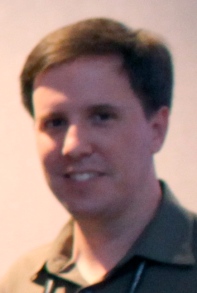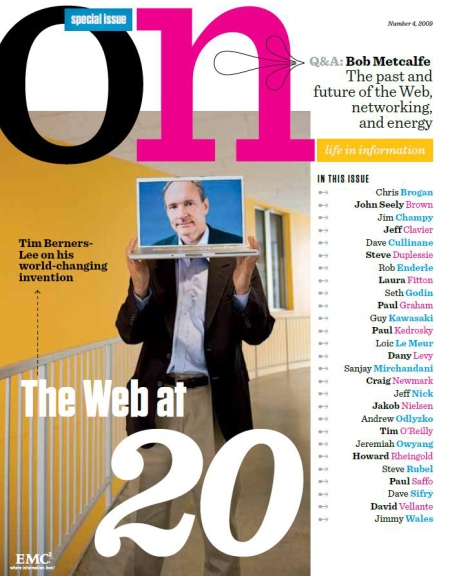The celebration of the Web at 20 years in ON Magazine has been getting nice coverage around the blogosphere. Gina Minks called for me to give my answers to the 3 questions which I had blogged about and interviewed other on, but not answered myself:
- How has the Web changed your life?
- How has the Web changed business and society?
- What do you think the Web will look like in 20 years?
The Web in my life
Growing up in the pre-Web days of the 80’s, I was drawn into the world of  computers. At college in the 90’s, I carried around my Eudora email disk and got on the Web using early versions of Netscape. I thought it was really cool that I could visit early websites and get basic information on some of the companies that I was interviewing with. I remember showing my girlfriend (now wife) some of these websites, and her reaction was that it seemed like a toy and why would anyone waste their time on that. Of course, her first job a year later was designing websites. Technology moves fast.
computers. At college in the 90’s, I carried around my Eudora email disk and got on the Web using early versions of Netscape. I thought it was really cool that I could visit early websites and get basic information on some of the companies that I was interviewing with. I remember showing my girlfriend (now wife) some of these websites, and her reaction was that it seemed like a toy and why would anyone waste their time on that. Of course, her first job a year later was designing websites. Technology moves fast.
The Web has changed my life by extending the network of people who I can keep in touch with. In the early days of the Web, first email and later instant messenger allowed me to keep in touch with friends and family over distance. Now, with the help of social media tools, I can stay connected with a much larger number of people. There are cousins, friends in far away places and former co-workers that I likely would lose contact with if it wasn’t for LinkedIn, Facebook and Twitter. The little updates that you see about their lives fill in the gaps in time between when you actually get to talk to them or see them.
The Web in business and society
The Web has greatly increased the velocity of information and reach of business. Companies share information and compete in a global marketplace that is greatly enhanced by connectivity of the Web. The Web gives us the opportunity to access lots of information about all topics. On the other hand, there is such a deep amount of information about topics that it is easy to not get a diverse view of the world or to get lost in a sea of noise.
[For a bit more, also see the discussion that I had with Louis Gray in my last post which he transcribed.]
The Web of 2030
With all of the changes that we’ve seen in the last 20 years (or even the Web 2.0 explosion in the last 5 years), it’s difficult to guess what the Web might look like in another 20 years. According to Nicholas Carr’s book, The Big Switch, Google’s initial goal was to help improve the way that people think (and it looks like his new book discusses whether Google is making us stupid).  In the future, computers should understand our environments and provide information based on semantics [see EMC’s CTO Jeff Nick’s discussion in ON Magazine] rather than searching in computer code (Boolean search, hashtags, etc). I’m not saying that in 20 years that we will be able to link our brains into computers (sure, the Matrix is a fun movie, but not the future that we want).
In the future, computers should understand our environments and provide information based on semantics [see EMC’s CTO Jeff Nick’s discussion in ON Magazine] rather than searching in computer code (Boolean search, hashtags, etc). I’m not saying that in 20 years that we will be able to link our brains into computers (sure, the Matrix is a fun movie, but not the future that we want).
While the technology of voice recognition has been around for many years and showing only modest progress, within the next 20 years, we may be able to simply talk with computers (to quote Scotty in Star Trek IV, “a keyboard, how quaint”). Live video between people will continue to play a larger role in how we interact with each other as bandwidth increases. It’s my hope that computers and the Web can continue to increase the ability to gather and utilize information as well as connect people.
____________________________________________________________________
To continue the conversation, I am tagging Natalie Corridan-Gregg (EMC), Aneel Lakhani (works for IBM, speaks for himself) and Andrea Meyer (Working Knowledge) to continue the #20years discussion.
UPDATE: For all of the posts on this topic, including the responses from Natalie, Aneel and Andrea – see the document on the EMC Community Network.



 Posted by Stuart Miniman
Posted by Stuart Miniman  The Web has become the universal source for information for practically any topic at any time, regardless of its source. It has also grown into the leading venue for communication with friends, colleagues, family and strangers. The Web has undone the traditional formats of scheduled information flow and has reduced many barriers that were geographically or class based. It has also allowed direct access to the authors of information in real time. As these barriers decrease, so to have some of the long held (now antiquated) barriers related to transparency and what information is valuable to be shared.
The Web has become the universal source for information for practically any topic at any time, regardless of its source. It has also grown into the leading venue for communication with friends, colleagues, family and strangers. The Web has undone the traditional formats of scheduled information flow and has reduced many barriers that were geographically or class based. It has also allowed direct access to the authors of information in real time. As these barriers decrease, so to have some of the long held (now antiquated) barriers related to transparency and what information is valuable to be shared.



